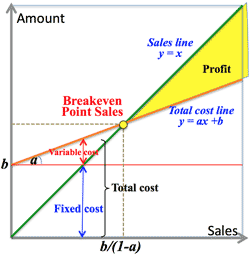Résumé |
Remarks |
>Top 0. BS and PL:
| Balanace Sheet (as of 31 Dec. xxxx) |
| Assets |
資産の部 |
| |
Cash |
|
現金&預金 |
| |
Maketable securities |
|
有価証券 |
| |
Notes & accounts receivables |
|
受取手形&売掛金 |
| |
Sales finanance receivables |
|
販売金融債権 |
| |
Inventories |
|
在庫 |
| |
□Gooods & Products |
|
□商品&製品 |
| |
□Work in progress (WIP) |
|
□仕掛品 |
| |
□Raw materials & Supplies |
|
□原材料&貯蔵品 |
| |
Deferred income taxes |
|
繰延税金資産 |
| □Total current assets |
□流動資産合計 |
| |
Property, plant, & equipment |
|
土地建物機械装置&運搬具 |
| |
Less accumulated depreciation & amortization |
|
- 累積減価償却 |
| |
Net property, plant, & equipment |
|
土地建物機械装置&運搬具(純額) |
| |
(Builidngs underconstruction) |
|
(建設仮勘定) |
| |
Goodwill, net accumulated amortization |
|
無形固定資産 |
| |
Allowance for doubtful accounts |
|
貸倒引当金 |
| |
Investment & other assets |
|
投資その他資産 |
| □Total assets |
□固定資産合計 |
Liabilities & Shareholder's Equity |
負債&純資産の部 |
| |
Notes payable |
|
支払手形 |
| |
Short-term debt |
|
短期借入金 |
| |
Long-term debt due in one year |
|
長期借入金(1年以内返済予定) |
| |
Lease obligations |
|
リース債務 |
| |
Account payable |
|
買掛金 |
| |
Income taxes payable |
|
未払法人税等 |
| |
Accured liabilities |
|
未払費用 |
| □Total current liablilities |
□流動負債合計 |
| |
Corporate bond |
|
社債 |
| |
Long-term debt |
|
長期借入金 |
| |
Lease obligations |
|
リース債務 |
| |
Deferred income taxies |
|
繰延税金負債 |
| |
Retirement benefit obligations |
|
退職給付引当金 |
| |
Other long-term liablities |
|
その他長期債務 |
| □Total liabilities |
□負債合計 |
| |
Capital |
|
資本金 |
| |
Capital surplus |
|
資本剰余金 |
| |
Retained earnings |
|
利益剰余金 |
| |
Accumulated other comprehensive income, AOCI |
|
(包括利益累積) |
| |
Less Treasury stock |
|
自己株式 |
| |
Valuation & translation adjustments |
|
評価換算差額等 |
| |
Minority interest |
|
少数株主持分 |
| □Total liabilities & shareholders' quity |
負債純資産合計 |
|
| Profit and Loss (xxxx - xxxx) >Top |
PL (for year ended 31 Dec., xxxx) |
| |
Sales |
|
売上高 |
|
| |
Cost of Sales |
|
売上原価 |
|
| □Gross Profit |
□売上総利益 |
粗利 |
| |
Selling, General, & Administrative cost (SGA) |
|
販売費&一般管理費 |
|
| |
Depreciation |
|
減価償却費 |
|
| □Total operating expenses |
□販売費&一般管理費合計 |
|
| □Operating income |
□営業利益 |
本業 |
| |
Nonoperation income |
|
営業外収益(利息配当為替) |
|
| |
Interest expenses |
|
支払利息 |
|
| |
Other Expenses |
|
営業外費用 |
|
| □Total nonoperationg expenses |
□営業外費用合計 |
|
| |
(Ordinary income) |
|
(経常利益) |
本業財テ |
| |
(Extraordinary profit) |
|
(特別利益) |
|
| |
(Extraordinary loss) |
|
(特別損失)評価損減損損失 |
|
| □Net income before income tax |
□税引前当期純利益 |
全活動 |
| |
Provision for income tax |
|
法人税住民税事業税 |
|
| Net Income |
当期純利益 |
手取り |
|
>Top 1. Find safety from BS:
- Credit items of BS:
- Credit: How the fund was procured:
- Liabilities: Borrowed capital; need to repay, otherwise the company will bankrupt.
- 'Equity to asset ratio' should be kept within reasonable level:
- Manufacturer: minimum 20%
- Wholesales, Trading firm: around 15%
- Warning level: less than 10% (except Financial institution)
- Safety merkemal of medium-long term, not necessary indicate that of short term.
- Net Assets: Shareholder's equity; need not to repay.
- Current Asset:
- mostly used as daily business operation; will be collected within around one year.
- Cash:
- should compare increase or decrease from previous year.
- Cash is the money which is not yet invested.
- Notes & Account receivables:
- First, receivable then could be changed into note.
- Note is much safer than receivable.
- Marketable securities:
- almost within one year operation; short-term government bond or corporate bond.
- Sales finance receivables:
- lease for sales (such as car)
- Deferred income tax:
- allowance calculated by 'Tax effect accounting' method.
- allowance for bad loans required by 80% of loans
- Allowance for doubtful accounts:
- doubtful notes and receivables; minus amount
- Debt items of BS:
- Notes and Account payable:
- probably bought raw materials, but not yet paid.
- Short-term liabilities;
- loan from main financing banks; should be repaid or roll-overed.
- Long-term liabilities with due within one year:
- Some long-term loan whose due date come within one year must be shifted from fixed liabilities to current liabilities.
- Lease obligations:
- Since 2009, this idem became obligatory.
- Accrued liabilities:
- unpaid amount against such as supply of services.
- Income taxes payable:
- The profit was determined about two months later from the closing of FY, then the tax amount was determined.
- Deferred income taxes:
- due to 'Tax effect accounting'.
- Solvency Analysis (current or liquid):
- assets which can easily be converted into cash.
- Solvency Ratio: to avoid bankruptcy, watching cash or cash equivalent.
- Current Ratio: Current assets / Current liabilities
- preferably >120%, but varies among industries.
- Quick Ratio (Acid Test): Liquid assets / Current liabilities >Top
- preferably > 100%
- here, 'liquid' means 'cash & cash equivalent' including 1) Cash, 2) marketable Security, 3) Note, 4) account Receivable; excluding inventory.
- Debt to Equity Ratio (D/E Ratio): Total liabilities / Net worth
- Fixed asset to Net Worth: Fixed assets / Net worth
- Priority against solvency risk: from shorter to longer; 1) Liquidity On Hand, 2) Quick Ratio, 3) Current Ratio, and 4) Capital Adequacy Ratio.
- Liquidity On Hand is much important than maintaining Capital Adequacy Ratio in economic recession, or the period of banks' reluctance to lend.
- Shareholders' Equity: funds which need not to return; including 1) Capital, 2) Capital surplus, 3) Retained earnings, and 4) Treasury stock.
- to change Capital, 2/3 vote at the shareholders' meeting is needed; but only majority as of Capital surplus.
- Treasury stock is used for a kind of shareholder return.
- Minority interest: minor shareholders' equity of affiliate companies, which also need not to return immediately; included in the numerator of Capital Adequacy Ratio.
- Capital Surplus is not necessarily cash; some was spent for investment, etc. The cash retained is displayed in the current assets.
- Liquidity On Hand = (Cash + Marketable securities + Borrowing facility) / Monthly sales >Top
- >1.7 months or 2.0 preferably or 1.0 minimum in SMB
- >1.0 month in large company.
- use maximum borrowing limit (or overdraft limit) from major banks; in emergent cases, increase of sales or cost cut would be difficult. Liquidity On Hand matters.
- the bottom of cash balance usually occurs just after the pay day.
- Efficiency of business:
- Efficiency Ratio:
- Assets to Sales: Total assets / Sales >Top
- Days Sales Outstanding (DSO), Collection period: Account receivable / Credit sales × 365
- Sales to Inventory: Sales / Inventory
- Profitability Ratio:
- Return on Sales: Net profit / Sales >Top
- Return on Assets (ROA); Net profit / Asset
- Return on Equity (ROE); Net profit / Equity
|
1. 貸借対照表から安全性を読む:
- BS
- 流動資産
- 現金&余韻
- 手形&売掛金
- 有価証券
- 販売金融債権: リース
- 繰延税金資産
- 貸倒引当金
- 負債=債務+債務以外
- 負債: liability, debt
- 債務: obligation, liability, payable
- 取得価格と時価
- 無形固定資産の扱い
- BSには取得原価記載
- 隠れた価値があり得る
- BSを読む投資家からBSの裏を読む透視家へ
| 安全性分析 Solvency Analysis |
| 手元流動性 Liquidity On Hand |
>1.7 month |
| 当座比率 Quick Ratio, Acid Test |
>100% |
| 流動比率 Current Ratio |
>120% |
自己資本比率 Equity Ratio (Capital Adequacy Ratio) |
>35% |
| 負債比率 Debt to Equity Ratio (Debt Equity Ratio) |
<150-200% |
| 固定比率 Fixed Assets to Net Worth; Fixed Ratio |
<100% |
| 効率性分析 Efficiecy Analysis |
総資産回転率
Total assets turnover, TAT |
|
| 売掛金回転日数 Days Sales Ouftstanding, DSO; Collection Period |
|
棚卸資産回転率
Inventory turnover |
|
収益性分析 Profitbility Analysis |
| 売上高利益率 Return on Sales |
>5% |
| 総資産利益率 Return on Assets, ROA |
>10% |
| 自己資本利益率 Return on Equity, ROE |
>20% |
- 安全性仕様の優先順位: 短期→長期
- 手元流動性
- 当座比率
- 流動比率
- 自己資本比率
|
>Top 2. Find profitability from PL:
- Sales: Check the difference with the previous FY.
- Sales amount is the major concern of the management.
- Increase of sales with decresing Assets to Sales (=pseudo scale expansion) may increse more loss according to the decrese of sales.
- Cost of Sales: costs required or spent directly related to production
- Gross profit = Sales - (Cost of Sales)
- Cost of Sales:
- Production Cost:
- Selling, General, and Adminstrative expenses (SGA): all expenses of operation not directly related to production.
- Non-operation income & expenses:
- interest income, interest expense, equity in net income of affiliates
- Extraordinary income & expenses:
- gain or loss on sale of fixed assets, gain or loss on sale of securities
- Cost of Sales:
- this is different from 'Production cost'.
- when materials are purchased; increase 'Raw material & Supplies'.
- when making started; increase Goods in process, or Work in progress (WIP)
- when making completed; shift all expenses to 'Goods & Products'.
- But the Cost of Sale is counted sold portion only.
- Beware particularly the changes of inventory in BS (as the bankful stage), as well as CF.
- Various Profit Ratios: >Chart
- Profit exists in the upper stream.
- 'Cost to sales ratio' and 'Gross profit to sales ratio' are complimentary; to keep lower level of Cost to sales ratio matters.
- Watch historical trend of such ratios.
- Depreciation cost continues longer period. (Committed cost)
- Comparison of such ratios with rival companies is essential.
- Net profit on sales are keenly watched by shareholders, as well as ROE.
- ROE and ROA: >Top
- Comparison with other competitors are important.
- Non listed company need not worry about ROE.
- The increasing trend of ratio both of ROE and ROA are important.
|
2. 損益計算書から収益性を読む:
- PLの構成
- 売上高 - 売上原価
=売上総利益
- - 販売費&一般管理費
- =営業利益
- +営業外利益 - 営業外費用
- =経常利益
- +特別利益 - 特別損失
- =税前当期純利益
- - 法人税等
- =当期純利益)
| 製造原価 Production Cost |
| 原価の3要素 (直接費+間接費) |
| 材料費 Material cost |
原料、購入部品費、燃料、消耗品、 |
| 労務費 Labor cost |
給与賞与、退職給付引当金繰入 |
| 経費 Other expenses |
減価償却、水道光熱、賃貸料、外注過去費、特許権使用料 |
| 期首仕掛品棚卸高 Beginning inventory (+) |
| 期末仕掛品棚卸高 Ending inventory (-) |
| Cost to Sales Ratio |
売上原価率=
売上原価/売上高 |
| Gross Profit to Sales Ratio (Gross Profit Margin) |
売上総利益率=
売上総利益/売上高 |
SG&A Expense Ratio |
販管費率=
販管費/売上高 |
| Operating Profit on Sales (Operating Margin) |
営業利益率=
売上利益/売上高 |
| Ordinary Profit on Sales |
経常利益率=
経常利益/売上高 |
Net Profit on Sales
(Net Profit Margin) |
純利益率=
純利益/売上高 |
|
>Top 3. Find profitability and corporate future from CF: (キャッシュフロー計算書と収益性・将来性)
-
| Cash Flow from Operating Activities |
営業活動によるキャッシュフロー |
| |
Net income |
|
税前当期純利益 |
| |
Depreciation & amortization |
|
減価償却費 |
| |
Adjustment of deferred taxes |
|
繰延税金調整額 |
| |
Impairment loss |
|
減損損失 |
| |
Allowance for doubtful accounts |
|
貸倒引当金 |
| |
Investment account fluctuations |
|
投資勘定評価減 |
| |
Sales of fixed assets |
|
固定資産売却損益 |
| |
Sales of securities |
|
有価証券売却損益 |
| |
Accounts reveivables fluctuations |
|
売掛金増減額 |
| |
Accounts payables fluctuations |
|
買掛金増減額 |
| |
Retirement benefits allowance fluctuations |
|
退職金給付引当金 |
| |
Receipt of interent & devidend |
|
受取金利&配当 |
| |
Payment of interest |
|
支払金利 |
| □Sub-total of CF from Operating Activities |
□営業活動によるキャッシュフロー |
| Cash Flows from Investing Activities |
投資活動によるキャッシュフロー |
| |
Change in short-term investment |
|
短期投資増減額 |
| |
Purchase of fixed assets |
|
固定資産取得額 |
| |
Sale of fixed assets |
|
固定資産売却額 |
| |
Long-term loans expenditure |
|
長期貸付金貸付支出 |
| |
Long-term loans recovered |
|
長期貸付金回収 |
| |
Purchase of securities |
|
有価証券取得 |
| |
Sale of securities |
|
有価証券売却 |
| |
Change in Affiliate stock |
|
子会社株式購入増減額 |
| □Sub-total of CF from Investing Activities |
□投資活動によるキャッシュフロー小計 |
| Cash Flows from Financing Activities |
財務活動によるキャッシュフロー |
| |
Change in short-term borrowings |
|
短期借入金増減 |
| |
Proceeds by long-term loans |
|
長期借入金収入 |
| |
Proceeds by issuance of corporate bond |
|
社債発行による収入 |
| |
Redemption of corporate bond |
|
社債償還支払 |
| |
Acquisition of treasury stock |
|
自己株式取得 |
| |
Cash dividends paid |
|
配当金支払 |
| □Sub-total of CF from Financing Activities |
□財務活動によるキャッシュフロー小計 |
| □Net increase in cash |
□キャッシュ純増 |
| □Cash at beginning of year |
□キャッシュ期首残高 |
| □Cash at end of year |
□キャッシュ期末残高 |
|
- "A profit in sales does not always mean sufficient money"; insolvency due to liquidity problems.
- Countermeasures: decrease inventory, keep balance of account receivable and payable.
- CF by Operating Activities:
- should be surplus in principle.
- basically calculated from Net Income +- Adjustments (Indirect method)
- Increase/Decrease of account receivable: minus/plus of CF
- Increase/Decrease of account payable: plus/minus of CF
- CF Margin= (CF by Operation)/Sales: around 7%
- CF by Investment Activities:
- Purchase of fixed assets > Depreciation
- this is needed to maintain current level of business operation.
- Watch purchase of long-term securities (usually no less than 3 months)
- CF by Financial Activities:
- Basically CF by Financial Activities become minus. (such as dividend)
- Capital increase makes CF plus.
- Well balanced CF:
- CF by investment and CF by financial additivities are minus within the range of plus of CF by operation. And the balance of CF gradually and steadily increases every year; making the company stronger.
|
- CFマージン:
- バランスの良いCF
- 営業CFがプラスで、その範囲内で
投資CFと財務CFがマイナス
- 毎年確実にCF残高が増加
|
>Top 4. How to read the essence of BS:
- Priority against solvency risk:
- Liquidity On Hand, 2) Quick Ratio, 3) Current Ratio, and 4) Equity Ratio.
- "Liquid quick current equity"
- Current Ratio= (Current Assets)/(Current Debt)
- Low current ratio Case-1: Railway company:
- Current ratio of Tokyu Railway; 30% (¥109B/¥362B, 2010)
- Inventory is almost zero; electricity could not be stored.
- Accounts receivable is very small.
- Prepaid card like Suica/Pasmo: when a customer buys prepaid card, the credit is current debt, and debt is cash. (Daily cash income)
- Such cash can be used for long-term asset management.
- Other utility companies such as Electric Power Co., or Telecom Co. are similar.
- High current ration Case-2:
- Hospital: patients pay 30% of medical fee. The remained 70% will be paid by the health union about two months later.
- Such 70% becomes account receivable (sleep for 2 months or more)
- In the case of Nursing Care Service; 90% becomes account receivable.
- Account payable is almost null; payroll is monthly basis.
- 120% of current ratio is not enough.
- in some cases hospitals may use leasing company to buy the account receivables (Factoring service)
- Increase if shareholders' equity is the best solution.
- Why BS is to be made?
- Answer: Japanese Corporation Law (Article 435) states to make BS and PL.
- SMB or even unlisted companies must conform to this rule.
- But 'deferred income taxes' does not occur except listed large companies.
- Japanese Financial Securities and Exchange Laws stated to make CF by listed large companies.
- Industry Laws (Electricity, Bank, Insurance, Telecom, etc) also binds relevant industry. (> Fig.)
- Remarks:
- Impairment Accounting: when a certain fixed assets could not be profitable, the book value would be devaluated. (as per Financial instrument & exchange law)
- Compulsory Devaluation is different; when the land became devaluated and could not recover any more, then the book value would be devaluated. (as per Corporation Law)
- Market Value Accounting: applied to the value of corporate bond and >Top derivatives and fluctuate according to the market value.
- While, Impairment Accounting is applied to all assets, and devaluated and never recover.
- Difference of Subsidiary Co. and Affiliated Co. (or Associated Co.):
- owns more than 50% shares: having a controlling interest
- Internal transaction is offset.
- minor shareholders' portion is adjusted.
- each item is consolidated.
- owns no less than 20% and no more than 50% shares: having significant influence.
- accounted by the equity-method.
- one-line consolidation (net consolidation)
- Payment Risk:
- SMB is not audited by CPA; thus check closely 1) Account receivables, 2) Inventory, and 3) Long-term debt.
- Easy account receivables may cause risk of 'Bad debt' and 'worsening of cash flow'.
- Sales to Inventory (Inventory Turnover):
- Sudden or constant increase of this ratio should be warning.
- Long-term Debt:
- In case of SMB, the shift of long-term debt approaching due date (within one year) from fixed asset to current asset is exempted. But this is a risky point.
- Deferred Tax Asset:
- Japanese Financial Services Agency guided Japanese banks to reserve 80% of 'doubtful loans'.
- But Tax Law only addmits losses caused by real bankruptcy;
- Loans: ¥10B
- enforced allowance for doubtful loan (80%): ¥8B
- tax for this allowance (40%) will be: ¥3.2B (deferred tax asset)
- this deferred tax will be returned as long as the bank's profit is more.
- Valuation asset is risky
- IFRS (International Financial Reporting Standards): >Top
- IFRS was issued by IASB (International Accounting Standards Board) in 2001
- IAS (International Accounting Standards) was issued by IASC (International Accounting Standards Committee, the predecessor of IASB) in 1973-2001.
- Defined 'Comprehensive Income (CI)', adding profit from PL and difference of asset by market value from BS.
- WACC (Weighted Average Cost of Capital) Top
- True and fair view override.
|
4. 貸借対照表を読む虎の巻
- BSのイメージ
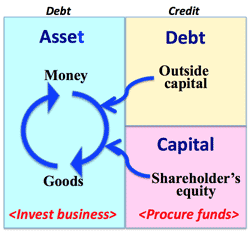 - 流動性リスク対策:
- Liquid quick current equity
- 鉄道会社の場合:
- 東急電鉄の流動比率は30%
在庫なし、日銭、売掛金少
- 会社法/金融商品取引法/業法:
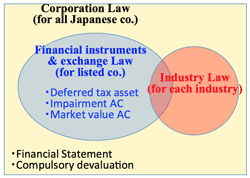 - 減損会計:
 - 留意事項
- 時価会計と減損会計
- 時価会計は有価証券とDelivertives対象
- 減損会計は全資産
- 子会社と関連会社の違い
- 売掛金に潜む二重のリスク
- だまされやすい科目:
売掛金、棚卸資産、長期借入金
- 上場会社の売掛金は監査法人が確認
- 貸倒リスク&資金繰悪化
- 棚卸資産:
- 商品の陳腐化による簿価減
- 在庫回転率=棚卸資産/月商
- 急激な在庫回転率の変化は不良在庫の可能性あり
- 評価性資産:
- 税効果会計
- 金融庁は銀行に対し、貸倒引当金80%計上指導
- 但し税法上は実際の倒産出ない限り損金処理不能。
- →繰延税金資産として計上
- 但し将来これ以上の利益がなければこの分戻りなし。
- 国際財務報告基準 (IFRS)
- IASBが2001制定
- 歴史的には
米国 FAS, Financial AC Standards
欧州 IAS, International AC Standards
- 加重平均資金調達コスト (WACC)
- 国債金利+Risk premium (5-10%)
|
>Top 5. PL and corporate management:
- Breakeven Point:
- Breakeven point sales = (Fixed cost)/(1- variable ratio) = b/ (1-a)
- Eg. Steel industry; Fixed cost is large, while variable ratio is small. It brings very large profit after breakeven point.
- Eg. Trading firm; Fixed cost is small, while variable ratio is large; It brings not so much profit after the breakeven point.
- Strangeness of Sales cost and Production cost:
- Premise: monthly fixed cost: ¥100M; Variable cost per piece ¥5K; Sales price per pc ¥20K; Sales volume per month 10K
| |
Monthly production Case-A: 10,000 pcs |
Monthly production Case-B: 100,000 pcs |
| Fixed cost/pc |
10,000 |
1,000 |
| Variable cost/pc |
5,000 |
5,000 |
| Sales cost |
15,000 |
6,000 |
| Profit |
50,000,000 |
140,000,000 |
| Inventory |
0 |
540,000000 |
- The above profit of Case-B is false profit, making large inventory and worsening cash flow.
- Sales amount by US Accounting Standard:
- Trading as an agent: sales amount is agent commission only.
- Profitability, Efficiency, and Safety are sometimes trade-off.
- Eg. Consulting firm; BS is smaller, but sales is considerably large, which means sales to asset ratio becomes higher.
-
| ①Equity Ratio 50% |
|
Profit 10
in all cases |
| Asset 100 |
Debt 50 |
ROA 10% |
| |
Equity 50 |
ROE 20% |
|
| ②Equity Ration 10% |
③Equity Ratio 90% |
| Asset 100 |
Debt 90 |
Asset 100 |
Debt 10 |
| Equity 10 |
Equity 90 |
| ROA |
10% |
ROA |
10% |
| ROE |
100% |
ROE |
11% |
| □ROE becomes higher according to the down of Equity ratio. |
| □ROE= ROA × Financial leverage |
| □ROA is more important target for management. |
- Why Sales matters:
- Sales is the contact point with society. Sales is the due return from the society in return for providing goods or services.
- Why Profit matters:
- Ongoing of the company
- Future investment
- Treatment improvement
- Return to shareholders
- Return to society, including payment of taxes
|
5. 損益計算書と会社経営:
- ROA=純利益/資産
=
(純利益/売上高) × (売上高/資産)
=売上高純利益率 × 資産回転率
- ROE=純利益/株主資本
=
(純利益/売上高) × (売上高/資産)
× (資産/株主資本)
=売上高純利益率 × 資産回転率
× (財務レバレッジ)
= ROA × 財務レバレッジ
= ROA / 自己資本比率
- 売上=社会との接点
- 利益の5目的
- 会社の存続延命
- 未来への投資
- 従業員の待遇改善
- 株主への還元
- 社会への還元、納税含め
- 金融Big Bang以降:
-
| 企業会計 Corporate Accounting |
| |
財務会計 Financial Accounting |
| |
|
制度会計 Legal Financial AC |
| |
|
|
証券取引法 Sec & Ex Law
for listed companies |
| |
|
|
商法 Commercial Law |
| |
|
|
税法 Tax Law |
| |
|
非制度会計 Non-Legal |
| |
管理会計 Management Accounting |
|
>Top 6. CF and money flow:
- Strength of the company:
- Free CF =(CF from Operation) - (CF from Investment) >Top
- or Free CF = (CF from Operation) - (Depreciation)
- CF from Investment includes 'long-term loans expenditure' (no less than 3 months, such as time deposits, buying equity.
- Here, investment for ongoing operation is assumed as the depreciation expenditure.
- How to use FCF?
- Financial improvement: to decrease interest-bearing debt
- Future investment: R&D, HRD, Recruitment
- Return to the shareholders: increase of dividend, purchase of treasury stock
- DCF (Discounted Cash Flow):
- Σ cf (n) / (1+i)^n
- Value of the company=(Present value of CF) - (Interest bearing debt)
- EBITDA (Earnings Before Interest, Taxes, Depreciation & Amortization) >Top
- Stock value of the company = EBITDA × n
- EBITDA × n (actual result of the past) is surer than Future CF (future expectation)
- How the bank evaluate the company: (SPecial FEB)
>Top
- Safety:
Bank is a low-margin business (2-0.1% = 1.99%). Their business is safety first, including getting mortgages.
- Profitability:
Bank has its own rating; 2 year consecutive deficit devaluate the rating.
- Future prospects:
Whether it is a promising industry and a promising company.
- Company Executives:
Personality of the company's CEO. Experience, Vision, Character, Home, Successor (in SMB)
- Profitability of the Bank:
BIS regulations (Basel Capital Accords: more than 8% Equity Ratio
in global operation, or 4% in domestic business only)
- the denominator includes 1) credit risk, 2) market risk, and 3) operational risk including crime, disaster, environment, operation, and own risks; particularly reflecting governance of bad loans, or business scale of the lenders; RA, Risk Assessment such as BCP, ISO31000
- BIS = Bank for International Settlements
|
6. キャッシュフロー計算書とお金の動き:
- 会社の強さ=FCFの2つの定義
- DCF
- EBITDA (金税減前利益)
- EBITDA ×n =EBITDA倍率
= 7 -8 times in M&A boom
= or
5 time in M&A downturn
- 投資サイクル:
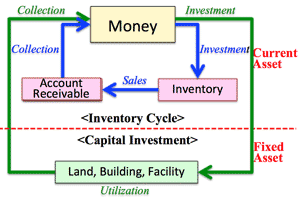 - 在庫サイクルと設備投資サイクル:
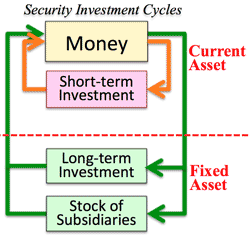 - 銀行が見る5ポイント:
- 安全性: 倒産回避
- 収益性: 2年連続赤字は降下
- 将来性: 業界と会社
- 経営者: 後継者(SMB)
- 銀行の収益性: BIS規制
|
>Top 7. Meaning of reading financial statements:
- To read the financial statements is a necessary condition, not a sufficient condition.
- To succeed business is to supply good goods or services to the client.
|
7. 財務諸表を読むことの意味:
- 財務諸表を読めることは必要条件
- 顧客に対して良品や良サービスの提供が重要
|



